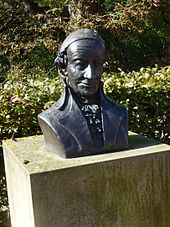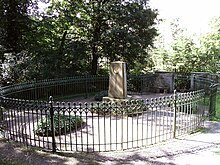Wielandgut (Oßmannstedt)
The Wielandgut Oßmannstedt is the estate in Oßmannstedt (near Weimar ), which was the residence of the poet Christoph Martin Wieland and his family from 1797 to 1803 .
history
Today's manor house and the English park were built on the former manor (see history of Oßmannstedt ) by the then Prime Minister of the Duchy of Saxony-Weimar-Eisenach, Count Heinrich von Bünau , from 1757 to 1762 . Between 1762 and 1775, Duchess Anna Amalia and her sons used the property as a summer residence. From 1783 to 1795 the Illuminatist August Dietrich Reichsgraf von Marschall auf Burgholzhausen was the owner of the "Schatullgut".
Wieland bought the property in 1797. He lived here with his large family for six years, following the example of the Roman poets Horace and Cicero as a “poetic squire”. In reference to their estates SABINUM and TUSCULUM, Wieland named his Oßmannstedter refuge OSMANTINUM. This is where the novels Agathodämon (1799) and Aristippus and some of his contemporaries (1800/1801) were written. In addition to the Weimar poets and scholars Goethe , Schiller and Herder , Heinrich von Kleist , among others, stayed at the von Wieland house in Oßmannstedt.
As a squire, not only Wieland was not too successful among the poets of the Weimar Classic . Goethe, too, had owned an estate in Oberroßla and had to give up almost at the same time.
In May 1803 the estate was sold to the Hamburg merchant Christian Johann Martin Kühne (1758–1827). From 1859 to 1896 it was owned by the family of Chamberlain John Grant of Glen Morrisson. He and his wife were buried next to the Wieland grave. This grave site was also bordered with a forged fence, which was also led around the grave site in a rounded shape. In 1953 the family's grave was leveled.
On August 27, 1896, ownership of the Wieland estate was transferred to the manor owner Otto Richard Bley. He immediately expanded the operational part of the property with stables and wagon depot to a considerable extent. On April 6, 1935, ownership passed to his son Bernhard Otto Bley. On July 19, 1947, the expropriation took place as part of the land reform. In 1953 Gut Oßmannstedt became the property of the National Research and Memorial Sites of Classical Literature Weimar (NFG). On May 17, 1913, 570 guests traveled as part of the general assembly of the Goethe Society on a day trip from Weimar to Oßmannstedt for a memorial service at Wieland's grave. On June 19, 1943, the Kleist Society, which met in Weimar, unveiled a memorial plaque on the manor house on a trip to Oßmannstedt.
The estate was divided in the late 1940s, the farm buildings and the surrounding wall were largely demolished and the manor house was converted into a school. Fundamental and extensive restoration work took place from 1968 to 1974 and from 2003 to 2005.
“Early summer 1984 ... During the GDR era, there was a polytechnic high school (POS) in the former residential and farm buildings, which bore the poet's name and whose teachers and students also looked after the gardens and parks. The memorial, which has existed since 1956 and was redesigned in 1983, consisted of two rooms on the ground floor ... "
museum
Today there is a museum with a research facility that opened on June 25, 2005. Jan Philipp Reemtsma describes the property as a “symbolic place for the German Late Enlightenment” , the restoration of which is largely due to him as a Wieland researcher and patron. The Wielandgut belongs to the Weimar Classic Foundation . On their behalf, the Weimar-Jena-Akademie operates an educational facility that offers not only cultural seminars but also accommodation and conference rooms.
Wieland's grave
The manor park on the Ilm harbors Wieland's grave, where he rests with his wife and Sophie Brentano . The latter, who had accompanied her grandmother Sophie von La Roche , former childhood friend and intermittent fiancé of Wieland, to visit the poet in Oßmannstedt in 1799 , fell seriously ill on her second visit in 1800 and died. At her personal request and with the support of Weimar Superintendent Johann Gottfried Herder , she was the first to find her final resting place in the estate park on the Ilmufer. A year later she was followed by Wieland's wife Anna Dorothea.
On January 25, 1813, five days after his death, the poet himself was buried here. The simple three-sided grave obelisk is adorned with the distich, specially created by Wieland for this purpose, "Love and friendship embraced the souls of relatives in life and their mortals are covered by this common stone". One speaks of the “most beautiful German poet's grave”.
Arno Schmidt enthused in 1958: "... A few meters away, under bushes, the touchingly narrow Ilm flows past in an outward curve - it is already one of our national shrines to which everyone should go on a pilgrimage once in their life to find their Om mani padme hum ('Oh, You jewel in the lotus! 'or' To walk the right path in the right way leads to perfection. ')
literature
- Peter-Henning Haischer: Christoph Martin Wieland. A citizen of the world in Weimar. Weimar 2015, ISBN 978-3-7374-0202-6 .
- Heinrich Bock : Visit to Oßmannstedt. In: Ute Harbusch, Gregor Wittkop (Hrsg.): Short stay: Forays through literary places . Wallstein, Göttingen 2007. pp. 74-76.
- Jan Philipp Reemtsma , Klaus Manger (eds.): Wielandgut Oßmannstedt . Klassik Stiftung Weimar, Weimar 2008, ISBN 978-3-7443-0142-8 . [Second edition, 1st edition 2005; with selected bibliography.]
- Stefan Grosz: The garden as a tusculum - Wielands country estate in Oßmannstedt. In: Die Gartenkunst , 19 (1/2007), pp. 87–92.
- Michael Zaremba : Christoph Martin Wieland - enlightener and poet. A biography. Böhlau, Cologne 2007, ISBN 978-3-412-22006-8 .
Web links
- Wielandgut on the website of the Klassik Stiftung Weimar
- www.im-weimarer-land.de/.../wielandgut_ossmannstedt.htm
- www.ossmannstedt.info
- Wieland research center
Individual evidence
- ↑ Grit Wainar: The manor park Ossmannstedt . Thesis. Ed .: Technical University of Dresden. Dresden 2003.
- ^ A b Klaus Manger, Jan Philipp Remtsma: Wielandgut Ossmannstedt . Ed .: Weimar Classic Foundation. Carl Hanser Verlag GmbH & Co. KG, 2005, ISBN 3-446-20690-6 .
- ↑ Servitus and deed of transfer. District court Apolda, land register of the community Oßmannstedt, Volume I, Sheet No. 23, 1st section in column 3
- ↑ Land Register for Oßmannstedt, Volume I, Sheet No. 23. Certificate of inheritance from February 16, 1935
- ↑ Based on the law for the implementation of the land reform of September 10, 1945, Article II, numbers 2 and 3
- ↑ Goethe Schiller Archive Weimar / GSA 149/176, p. 220
- ↑ Kleist Museum Frankfurt / Oder
- ↑ cit. after Heinrich Bock: visit to Oßmannstedt. In: Ute Harbusch, Gregor Wittkop (Hrsg.): Short stay: Forays through literary places. P. 75.
- ^ FAZ of February 14, 1970
- ^ Arno Schmidt: Wieland or the prose forms. Funkessay. 1958.
Coordinates: 51 ° 0 ′ 49 ″ N , 11 ° 25 ′ 32 ″ E






